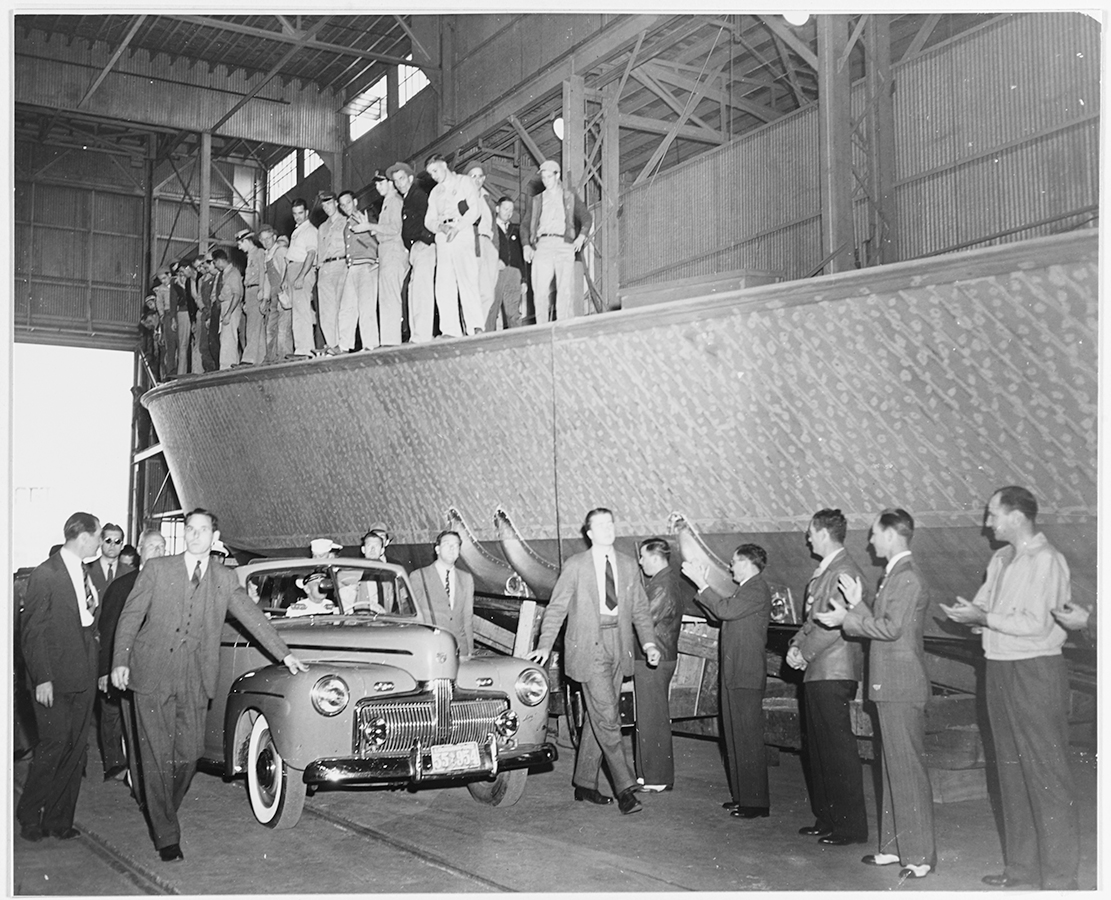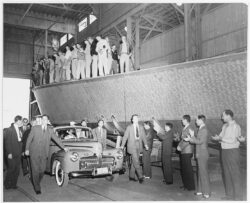Higgins Industries
During World War II, Higgins Industries designed 92 percent of US Navy vessels, the majority of which were produced by workers in New Orleans.

Naval History and Heritage Command
President Franklin D. Roosevelt Touring Higgins Industries
Even though Baton Rouge, Shreveport, and Lake Charles became important production centers for military equipment during World War II, New Orleans was the biggest supplier in Louisiana, and Higgins Industries was the city’s largest and most prominent production facility. Its production of naval craft was so important that General Dwight Eisenhower referred to owner Andrew Higgins as the man who “won the war for us” upon meeting him after the conflict ended.
Pre-War
Andrew Jackson Higgins moved from his native Columbus, Nebraska, to Mobile, Alabama, in 1906 and on to New Orleans in 1910 to find a business in which he could be successful. His New Orleans lumber business failed in 1922, and he began designing and building boats. He organized Higgins Industries in 1932 to manufacture boats for various uses after his designs set speed records from New Orleans to St. Louis, Missouri, in 1930 and 1931.
Higgins developed a boat that was able to jump over logs and small spits of land without incurring damage, and that design evolved by 1936 into the Higgins Eureka, a thirty-six-foot motorboat that could rush upon a beach without damage. Oil company officers and fur trappers quickly realized how useful the boat could be in swampy locations and placed orders for boats that were used in the marshes of Louisiana, the Persian Gulf, the Amazon River Basin, and locations in Asia.
World War II
Higgins first sought military contracts in 1934, but naval officers were not yet ready for his innovative designs. He sold Eurekas to the US Army Corps of Engineers and the US Biological Survey in 1936, beginning a profitable association with the federal government. Higgins Industries engineers modified the Eureka design to accommodate military needs by 1938, and the company sold the resulting landing craft to the United States, Britain, Finland, and Holland.
Higgins built PT (Patrol Torpedo) boats in New Orleans but is best known for “Higgins Boats,” as they were called during World War II and after. The landing craft were built for special purposes, including transporting and unloading troops, tanks, jeeps, and other military equipment and cargo from ships onto beaches.
Higgins also planned a boatbuilding procedure that incorporated moving assembly line techniques that shortened the production time for large vessels known as Liberty Ships. His plans called for building a vast new shipway upon which several ships would be built at the same time. Workers would build each ship from prefabricated panels as it slid toward the water.
Higgins hoped to expand into aircraft production, but military decisions to cancel contracts for Curtiss C-76 Caravans and C-46 Commandos led to him building only one airplane during the war. His Michaud plant reportedly produced some components for the Manhattan Project to build the first atomic bomb.
Higgins Industries became one of the largest employers in Louisiana. It employed about four hundred workers in September 1940. That number rose to about eighteen hundred workers in 1941 and about twenty thousand in 1944 employed in seven production facilities in New Orleans. Higgins’s need for employees was so great that the company engaged individuals who owned trucks to transport workers from locations miles away from the city. Higgins also employed women and African Americans to help fill his need for labor. The advantages of steady work at a good pay scale enticed many agricultural workers to make the commute every day, and their former employers complained to government officials about their resulting lack of labor to produce needed agricultural products.
The company and the city both profited from these payroll dollars. Higgins Industries’s net sales increased from almost $422,000 in 1937 to just over $10 million in 1941 and to $144 million in 1944.
Higgins’s contributions to the American war effort were so great, that in September 1943, Higgins Industries had designed or built 92 percent of the 14,072 vessels in the US Navy, and the majority were products of New Orleans facilities.
Labor Disputes
Higgins Industries also became involved in one of the largest labor disputes in Louisiana during World War II. (The other was a conflict at Gulf States Utilities in Baton Rouge during 1941–42). The Higgins dispute arose in 1945 and began when US Navy officials decided that ships under construction at Great Lakes shipyards would be transported to ice-free locations for completion as the winter of 1944–45 approached. Higgins agreed to complete a portion of them.
The US Maritime Commission classified the work as “new construction” and authorized the company to pay workers time-and-a-half for overtime work on the ships. Unions declared the work to be “ship repair or conversion” and demanded double pay for overtime work. The commission refused to let Higgins pay the higher rate. The unions directed their members not to work on the “hot” ships, thus preventing the thirty to fifty ships Higgins expected from being sent to New Orleans. He notified his workers that their contracts would be terminated on January 1, 1945. The Congress of Industrial Organizations complicated the situation when it filed for an election within the company as it sought to replace the American Federation of Labor which then represented Higgins workers.
The tense situation continued through 1945. About seven thousand Metal Trades and Building Trades workers staged a strike in early June that also idled about five thousand other workers ostensibly because Higgins hired returning servicemen without requiring them to join unions. The War Labor Board ordered the strikers to return to work on June 5, but they refused to work until June 13, after union leaders informed them that US Army and Navy officials maintained that the strike deprived their services of badly needed equipment.
Higgins became increasingly frustrated with the unions, announcing in early June that about fifteen hundred workers at his City Park plant would not be needed in the future. Higgins Industries Treasurer Morris Gottesman announced in mid-August that canceling the company’s remaining $20 million in military contracts meant that about two-thirds of its employees would be laid off. Higgins announced in late October that he would shutter his remaining New Orleans plants, open new production facilities under a new business organization, and devote himself to ensuring that workers in the future could obtain work “without paying tribute to anybody”—that is, not have to join a union and pay dues to obtain employment.
Postwar
Continued labor disputes eventually led Higgins to close his boatbuilding operations in New Orleans. His legacies include the enormous Michaud Ordnance Plant constructed in 1940 for World War II production. The plant produced some equipment for the Korean War and components for the US space program. Higgins died in New Orleans on August 1, 1952, and is buried in Metairie Cemetery.
